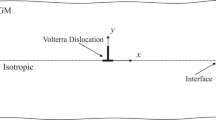Abstract
A method using the conventional finite elements and a finite domain energy integral, Ĵ, was applied to determining the dynamic stress intensity factors for rapidly propagating cracks not only in linear elastic but also in viscoelastic bodies. In order to simulate crack propagation, a node release technique was employed in which the nodal force near the crack tip was gradually reduced to zero according to the prescribed scheme. Several schemes were tested and the most satisfactory result was found to be obtained by the linear relaxation scheme. The dynamic stress intensity factors were determined by evaluating the Ĵ integral. Three seemingly different representations of Ĵ-integral were used and each result for linear elastic problems was in good agreement with the analytical solutions and other available numerical results. The dynamic stress intensity factors for viscoelastic problems were also determined by using a proper representation of Ĵ-integral.
Similar content being viewed by others
References
Anderson, J.M.; King, W.W. (1977): Singularity-element simulation of crack propagation. In: Hahn, G.T.; Kanninen, M.F. (eds): Fast fracture and crack arrest. ASTM STP 627, p. 123–134
Aoki, S.; Kishimoto, K.; Kondo, H.; Sakata, M. (1978): Elastodynamic analysis of crack by finite element method using singular element. Int. J. Fracture 14, 59–68
Aoki, S.; Kishimoto, K.; Sakata, M. (1981): Energy-release rate in elastic-plastic fracture problems. ASME J. Appl. Mech. 48, 825–829
Aoki, S.; Kishimoto, K.; Sakata, M. (1984): Energy flux into process region in elastic-plastic fracture problems. Eng. Fract. Mech. 19, 827–836
Atluri, S.N. (1982): Path-independent integrals in finite elasticity and inelasticity, with body forces, inertia, and arbitrary crack-face conditions. Eng. Fract. Mech. 16, 341–364
Atluri, S.N.; Nishioka, T. (1985): Numerical studies in dynamic fracture mechanics. Int. J. Fracture, 17, 245–261
Baker, B.R. (1962): Dynamic stresses created by a moving crack. ASME J. Appl. Mech. 24, 449–458
Broberg, K.B. (1960): The propagation of Brittle crack. Arkiv for Fysic 18, 159–192
Freund, L.B. (1972): Energy flux into the tip of an extending crack in an elastic solid. J. Elasticity 2, 341–349
Freund, L.B. (1973): Crack propagation in an elastic solid subjected to general loading, 3: stress wave loading. J. Mech. Phys. Solid 21, 47–61
Kishimoto, K.; Aoki, S.; Sakata, M. (1980a): On the path independent integral-Ĵ. Eng. Fract. Mech. 13, 841–850
Kishimoto, K.; Aoki, S.; Sakata, M. (1980b): Dynamic stress intensity factors using Ĵ-integral and finite element method. Eng. Fract. Mech. 13, 387–394
Kishimoto, K.; Aoki, S.; Sakata, M. (1982): Use of Ĵ-integral in dynamic analysis of cracked linear viscoelastic solids by finite-element method. ASME J. Appl. Mech. 49, 75–80
Kobayashi, A.S.; Mall, S.; Urabe, Y.; Emery, A.F. (1978): A numerical dynamic fracture analysis of the three wedge-loaded DCB specimens. In: Luxmoore, A.R.; Owen, D.R.J. (eds): Numer. Meth. Fracture Mechanics, pp. 673–684. University College Swansea
Mulluck, J.F.; King, W.W. (1980): Fast fracture simulated by conventional finite elements: A comparison of two energy-release algorithms. In: Hahn, G.T.; Kanninen, M.F. (eds): Crack arrest methodology and applications. ASTM STP 711, 38–53
Nakamura, T.; Shih, C.F.; Freund, L.B. (1985): Computational methods based on an energy integral in dynamic fracture. Int. J. Fracture 27, 229–243
Newmark, N.M. (1962): A method of computation for structural dynamics. Trans. ASCE 127, 1406–1435
Nishioka, T.; Atluri, S.N. (1980): Numerical modelling of dynamic crack propagation in finite bodies by moving singular elements, Part 1: Formulation, Part 2: Results. ASME J. Appl. Mech. 47, 570–583
Nishioka, T.; Atluri, S.N. (1983a): Path-independent integrals, energy release rates, and general solutions on near-tip fields in mixed-mode dynamic fracture mechanics. Eng. Fracture Mech. 18, 1–22
Nishioka, T.; Atluri, S.N. (1983b): A numerical study of the use of path independent integrals in elasto-dynamic crack propagation. Eng. Fracture Mech. 18, 23–33
Nishicka, T.; Atluri, S.N. (1984): Path-independent integral and moving isoparametric elements for dynamic crack propagation. AIAA J. 22, 409–414
Rydholm, G.; Fredricksson, B.; Nilsson, F. (1978): Numerical investigations of rapid crack propagation. In: Luxmoore, A.R.; Owen, D.R.J. (eds): Num. Meth. Fracture Mechanics, pp. 660–672. University College Swansea
Tada, H.; Paris, P.; Irwin, G. (1973) : The stress analysis of cracks handbook. Del Research Corporation
Author information
Authors and Affiliations
Additional information
Communicated by G. Yagawa, April 17, 1986
Rights and permissions
About this article
Cite this article
Aoki, S., Kishimoto, K. & Sakata, M. Finite element computation of dynamic stress intensity factor for a rapidly propagating crack using Ĵ-integral. Computational Mechanics 2, 54–62 (1987). https://doi.org/10.1007/BF00282044
Issue Date:
DOI: https://doi.org/10.1007/BF00282044




